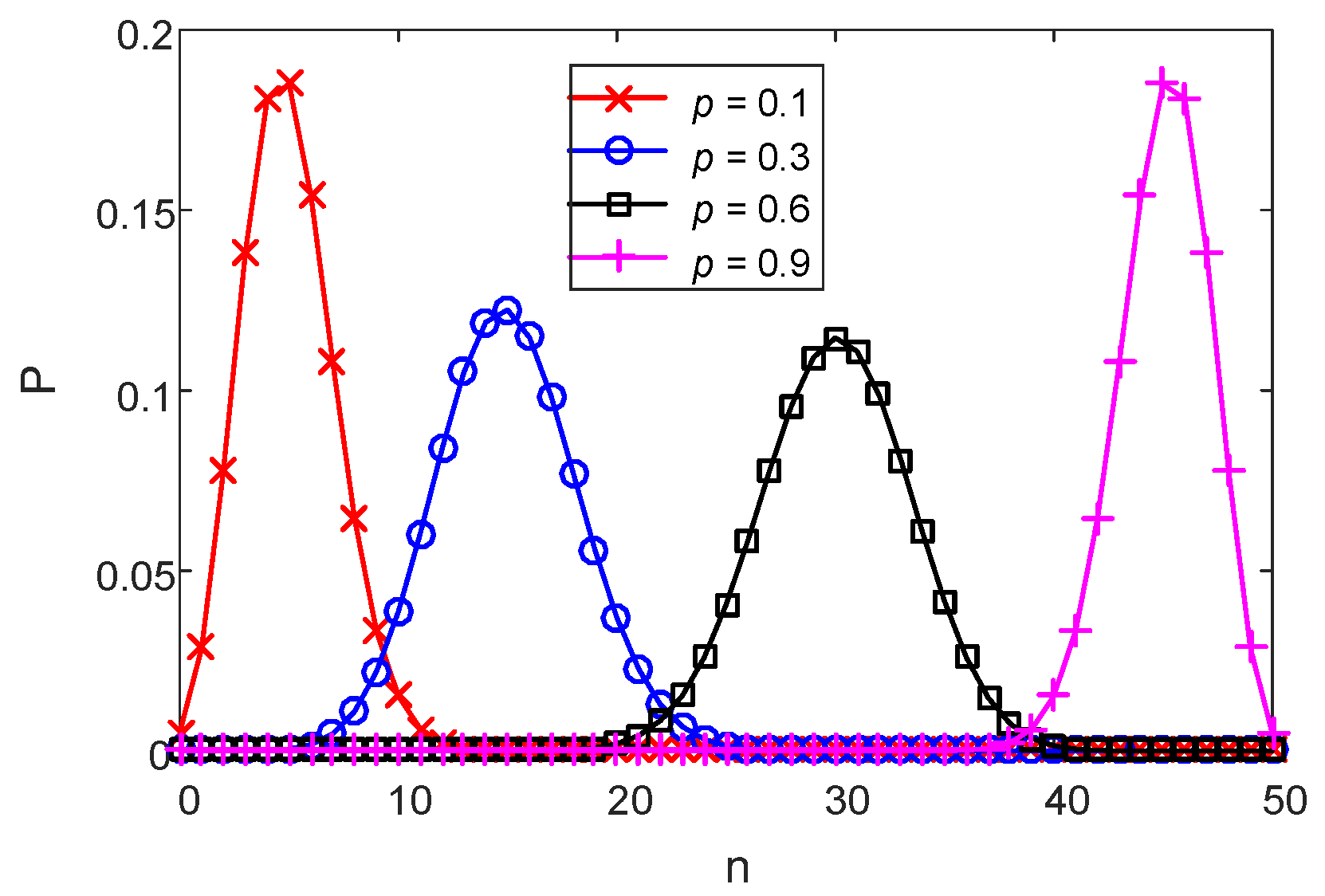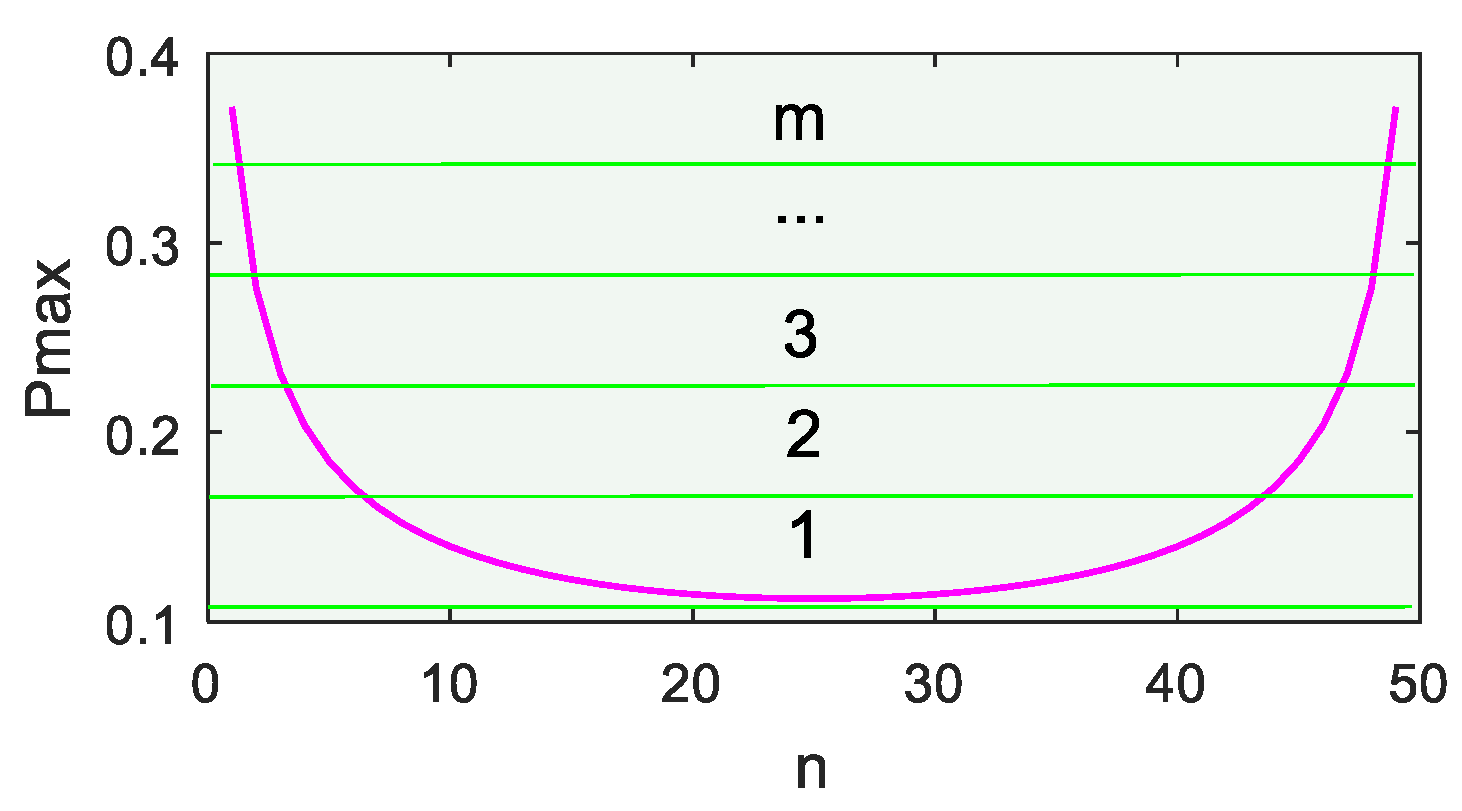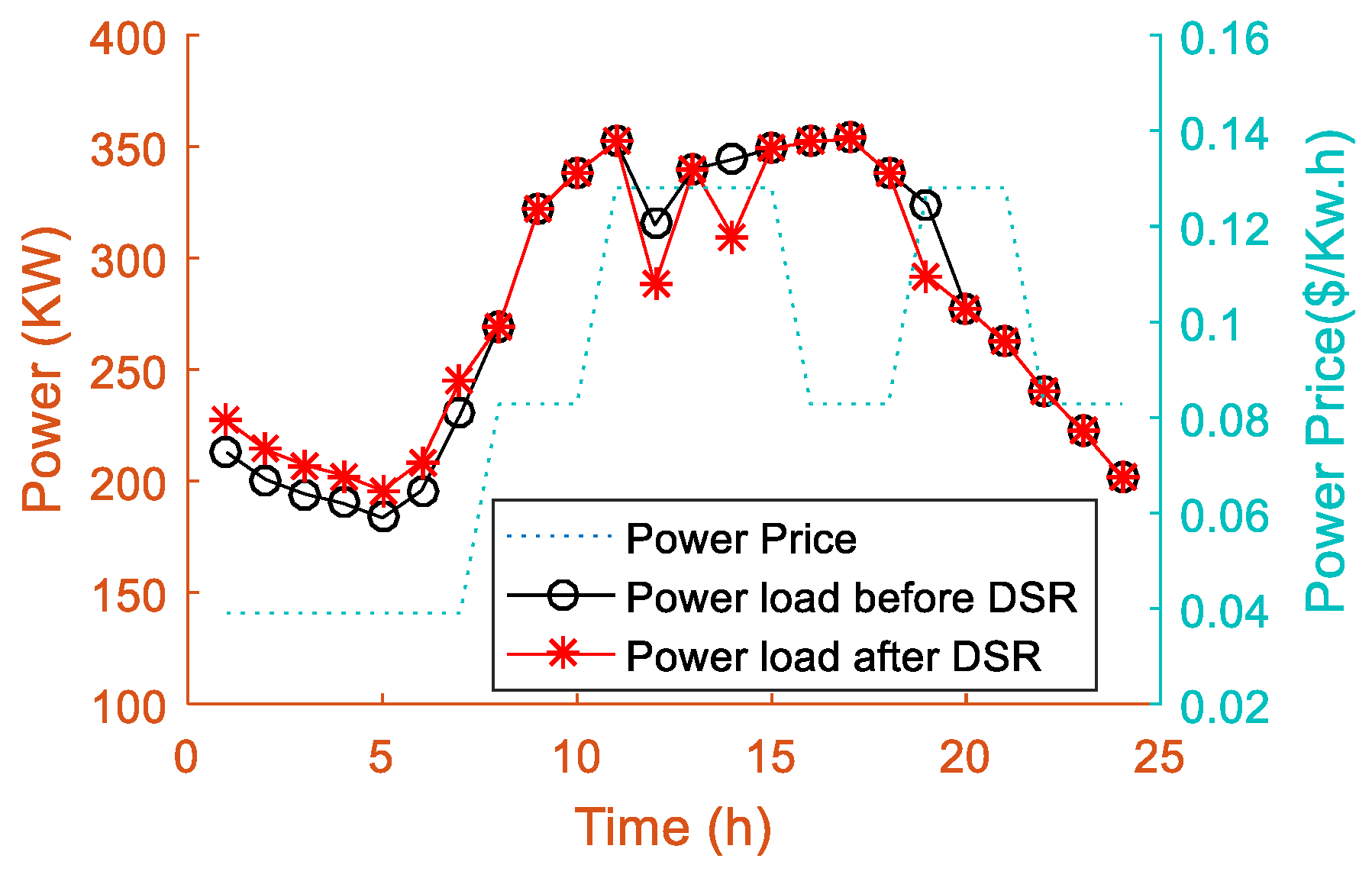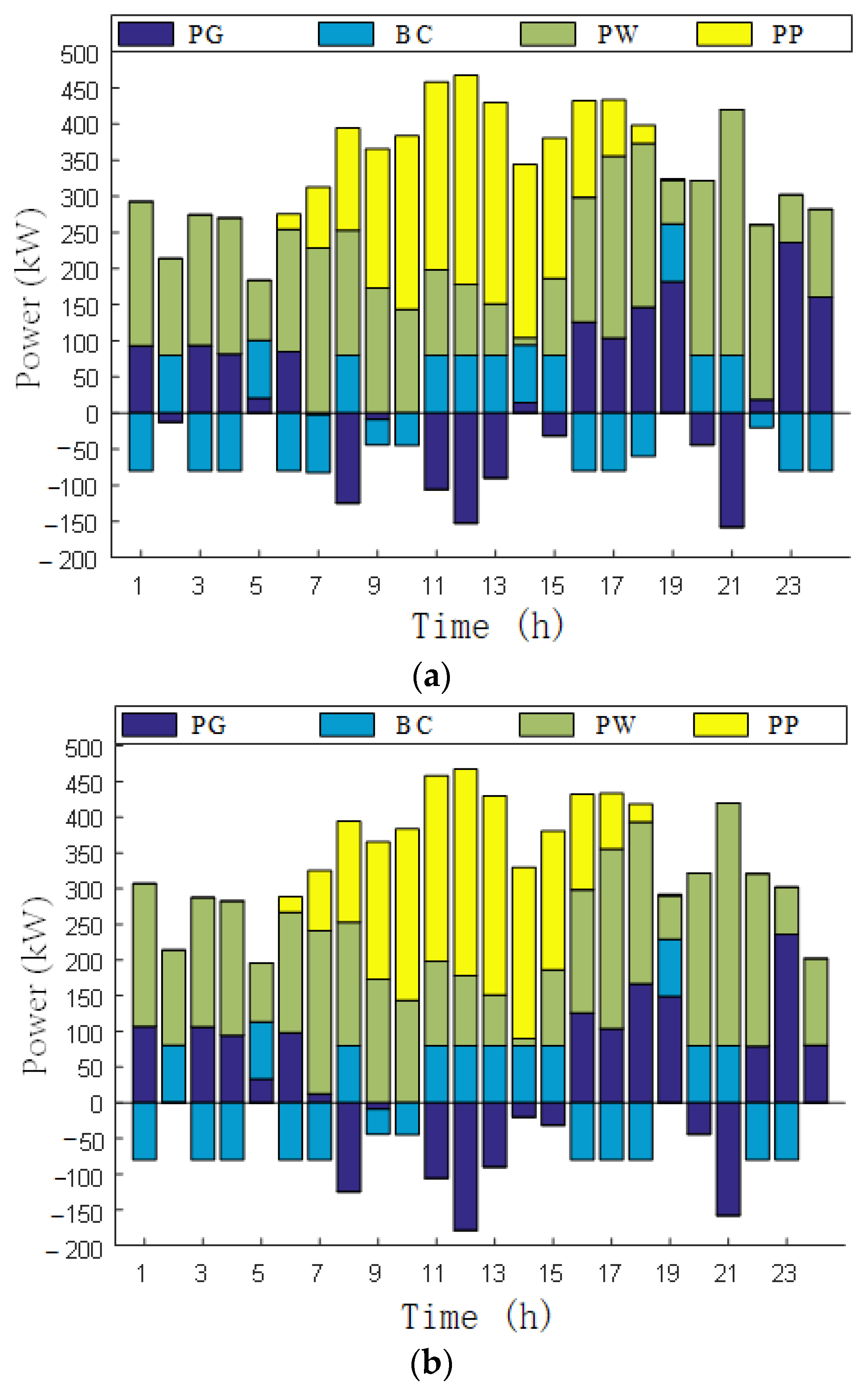1. Introduction
The problems of energy and environment have become important current issues, and integrated energy systems can effectively and economically solve these problems [
1]. A microgrid is located at the end of the energy network. As a form of distributed generation, the application of a microgrid has become more and more extensive in the world due to its contribution to green environmental protection [
2]. The fluctuating output power of renewable energy can destroy any interconnected large power grid. When a large amount of renewable energy is deployed on remote islands, it is difficult to connect the power grid with these renewable energy sources. Microgrids can isolate renewable energy power generation equipment to avoid the instability of large power grids [
3].
A microgrid is a power distribution system, and distributed power, energy storage equipment, and load are its main equipment [
4]. Photovoltaic power generation and wind turbine power generation, as distributed power sources, are developing rapidly [
5]. The modeling methods proposed for these devices have achieved some results. According to the modeling method of graph theory, the multi-energy flow of an integrated energy system is modeled [
6]. Ref. [
7] proposes an automatic modeling method to model small combined heat and power generation equipment as input and output matrices. However, the product of scheduling factors and decision variables used in the coupling matrix is nonlinear, and nonlinear constraints are added. Ref. [
8] expresses the devices of microgrids as directed graphs, which simplifies the analysis, research, design, and optimal operation of microgrids. However, there is no unified theoretical method for automatic modeling of these devices.
The energy storage system in a microgrid adds the flexibility of an energy system, but the difficulty of energy control and management also increases. Therefore, an energy management strategy (EMS) is very important in a microgrid [
9]. The literature [
10] studies the demand side response, the energy market, the optimal operation of wind power generation and storage systems, considering the uncertainty of demand, market price, and wind speed. The literature [
11] uses intelligent optimization algorithm to obtain the optimal allocation scheme, but the intelligent algorithm is relatively complex, and it is easy to obtain local solutions. In [
12], a nesting energy management strategy is proposed, which does not consider the uncertainty of the loads, and the uncertain parameters are not concerned.
Ref. [
13] solves a constrained optimization problem, and gives the optimal control strategy in an islanded microgrid system. However, due to the increase of load uncertainty, it is difficult to make real-time decisions. In the optimal dispatch of a microgrid, many researchers are focused on the optimization between various distributed power sources and energy storage systems, but less on the load regulation [
14]. However, with the development of microgrids, a demand side response (DSR) has been paid more and more attention in EMS. Ref. [
15] puts forward an optimal dispatching model of flexible cold, heat, and electricity demand side responses, which is used to improve the energy supply flexibility of an isolated microgrid. The literature [
16] proposes a zoning EMS control method of a DC microgrid by using a controllable load in demand management, which improves the stability of the demand side operation of a power grid. Ref. [
17] puts forward a modified model of a demand side response to implement seven DSR strategies, which can improve the load factor. Household refrigeration equipment can be used for electrical load shifting from a peak demand period to an off-peak demand period [
18]. However, energy systems of microgrids usually carry many loads, which are driven by variables, and it is difficult to forecast demand correctly [
19]. Technology innovation is very important for obtaining renewable energy, improving energy efficiency, and reducing carbon dioxide emissions [
20].
To sum up, an automatic and general modeling tool is needed for microgrid devices, which can be used to automatically create system structure models. Using DSR in a microgrid can improve the performance of EMS, promote the consumption of new energy, and improve the efficiency of equipment. However, most of the existing literature only considers the demand side response of a deterministic load. There is not much research on the differences of individuals participating in demand side response loads, and further research is still needed.
In this paper, a microgrid model based on an energy circuit diagram is established. A demand side response model is proposed, which includes an unresponsive electric load, non-interruptible electric load and interruptible electric load. Binomial distribution is used to describe the uncertainty of a participating load response, which solves the problem of individual discrimination in a participating load response. Some loads are shut down by using the difference of load probability, and customer satisfaction is improved. The operating cost of a microgrid energy system is reduced by using the response of energy system to energy price.
Different from all previous methods, probability distribution is used to determine the future load demand, which is determined by the binomial distribution probability model. There is no complicated calculation in the whole process. In addition, the model can be applied to the optimization calculation. The main contributions are as follows:
- (1)
A generic modeling method combined energy circuit theory can be used easily create a model of a microgrid.
- (2)
A DSR model is proposed, which includes non-interruptible electrical loads, shiftable undisturbed electrical loads and shiftable disturbed electrical loads.
- (3)
A DSR method based on binomial distribution is proposed. By applying the probability of loads and changing the return coefficient of loads, the problem of individual differences in demand side responses is solved.
- (4)
A MILP based on DSR is applied on a microgrid. The usage of the proposed method greatly improves the satisfaction value of users.
The rest of this paper is organized as followed:
Section 2 presents the microgrid model based on an energy circuit diagram.
Section 3 introduces the respond demand method based on binomial distribution.
Section 4 proposes a system management method based on a demand side response. Case studies are conducted in
Section 5.
Section 6 shows the conclusions.
3. Respond Demand
In the system shown in
Figure 1, the storage battery provides energy to supply the load if PV and WT cannot meet the load energy. However, the storage battery cannot fully meet the energy demand in heavy load in a microgid, and it can buy electricity from the power grid. When the electricity produced by PV and WT is greater than the load demand, it can also sell electricity to the power grid. In order to reduce the disturbance of a microgrid to a large power grid, the energy exchange between a microgrid and a large power grid should be reduced as much as possible. Considering the price of electricity exchanged with the grid, we must initiate the demand side response to minimize the cost, forcing some loads to stop or start. The demand side response can improve the charging and discharging times of the battery and reduce the operating cost of the microgrid.
We can use probability distributions to determine potential, time-dependent, and future load demands that are addressed by the proposed model. In [
25], the load combination probability is used to determine the order of demand side response loads. If we have
k loads, the number of combination probabilities is 2
k, and the combination probabilities need to be sorted in decrease turn. Due to the large amount of calculation if
k is large, a load probability demand side response method based on binomial distribution is proposed in this paper.
3.1. Load Model
The electrical loads are divided into non-interruptible electrical loads (NI), shiftable undisturbed electrical loads (SU), and shiftable disturbed electrical loads (SD).
3.1.1. Non-Interruptible Electrical Loads (NI)
The probability of non-interruptible electrical loads is 1, and the load model is:
where
n represents the number of users,
T represents working time,
represents the load at time
t,
represents the load of the
i-th user.
3.1.2. Shiftable Undisturbed Electrical Loads (NI)
It is assumed that the working time of shiftable undisturbed electrical loads is [
t1,
t2]. The working time is
t2 −
t1 h. The NI load model is as follows:
where
it represents the load of NI equipment at time
t,
represents the load probability of the
i-th user, which is determined by the following equation:
3.1.3. Shiftable Disturbed Electrical Loads (SD)
Shiftable disturbed electrical loads can be deactivated at any time. The SD load model is as follows:
where
represents the load of SD equipment at time
t,
represents a binary variable, which is determined by the following equation:
3.2. The Binomial Distribution Function
Considering the different characteristics of each SD load, the start-stop of the load is determined by the binomial distribution function. The
n loads can be regarded as
n random variables
x, obeying binomial distribution with parameters
n and
p, and the distribution function is as follows:
where,
According to the load probability, the order of stopping the load is decided. It is assumed that
p is randomly selected in [0.1 0.9], and
n = 50. The binomial distribution probability is shown in
Figure 4. The maximum probability
Pmax of different
p values is different, and the individuals of load response can be determined by the value of
p and
Pmax.
The maximum probability curve of binomial distribution from 0.01 to 0.99 is shown in
Figure 5. The load number corresponding to
Pmax is (
n + 1)
p rounded. According to the classification of interruptible loads, loads with different importance are defined in different areas. The curve in
Figure 5 is divided into
m areas as shown in
Figure 6. The first interruptible load is defined in the
m area, and the 1 area is the last interruptible load. The load near
Pmax is disconnected first, so as to improve customer satisfaction.
3.3. Method of Demand Side Respond
In addition to considering the combination probability of load, in order to ensure that the deactivated load can be put to use in the next period of time, a return coefficient λ is set for each load, and the initial value is randomly set. After the load is disabled in the previous period, the value of λ becomes 1. At the same time, the demand side response should consider the following points:
- (1)
The relation of the total load and the energy of PV and WT.
- (2)
The charging state of the battery.
- (3)
Probability of deactivating load.
- (4)
The load with a coefficient of 1 is no longer disabled.
- (5)
The price of the power grid.
6. Discussion-Comparison
In this paper, the DSR method based on binomial distribution is applied to the EMS in microgrids. The method is similar to that in [
25]. The differences between them are explained below. Ref. [
25] calculates the probability of a specific combination of loads. All the probabilities of combinations must be calculated. The probabilities of 2
k combinations must be calculated if there are
k loads. Therefore, the amount of calculation is very large if there are too many loads and the calculation will be difficult. In this paper, we need to calculate k times by formula 11 under the same conditions.
Unlike all previous research model methods, our general model can be used to consider multiple energy sources at the same time. The model is based on the energy circuit theory, and the energy includes electricity, gas, heat, and other energy sources. Therefore, when there are multiple energy sources such as electricity, gas, and heat in the microgrid, the proposed model in this paper is still applicable. The probability distribution is used to determine the future load demand. Any load demand can be expressed as a proposed model because the probability of the load can be determined according to its importance and is independent of other factors. In addition, the model can be combined with an optimization algorithm for real-time decision-making.

















